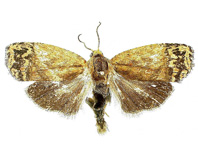Abstract
A new peritrichous ciliate, Cothurnia salina n. sp., collected from a brine pond of a salt factory in Yantai, China, was investigated based on live observations, silver staining method and molecular phylogenetic analysis. The diagnosis for this new taxon: body elongated columnar, in vivo 80–98 × 12–19 µm; lorica barrel-shaped, with aboral part heavily thickened; stalk extremely short, with approximately ½ of its length within the lorica; macronucleus wormlike, longitudinally oriented; single contractile vacuole ventrally located; pellicle with conspicuous parallel transverse striations, 62–73 from aboral trochal band to peristome and 32–38 from aboral trochal band to scopula; infundibular polykinety 3 (P3) consisting of two ciliary rows, which are equal length, parallel to each other and terminate adstomally between P1 and P2. Small subunit (SSU) rRNA gene trees revealed that the new species clustered with other members of the family Vaginicolidae as expected.
References
Castresana, J. (2000) Selection of conserved blocks from multiple alignments for their use in phylogenetic analysis. Molecular Biology and Evolution, 17, 540–552.
http://dx.doi.org/10.1093/oxfordjournals.molbev.a026334Chen, Y., Zhao, Y., Pan, X., Ding, W., Al-Rasheid, K.A. & Qiu, Z. (2014) Morphology and phylogeny of a new Frontonia ciliate, F. paramagna spec. nov. (Ciliophora, Peniculida) from Harbin, northeast China. Zootaxa, 3827, 375–386.
http://dx.doi.org/10.11646/zootaxa.3827.3.7Cho, B.C., Park, J.S., Xu, K. & Choi, J.K. (2008) Morphology and molecular phylogeny of Trimyema koreanum n. sp., a ciliate from the hypersaline water of a solar saltern. Journal of Eukaryotic Microbiology, 55, 417–426.
http://dx.doi.org/10.1111/j.1550-7408.2008.00340.xEsteban, G.F. & Finlay, B.J. (2003) Cryptic freshwater ciliates in a hypersaline lagoon. Protist, 154, 411–418.
http://dx.doi.org/10.1078/143446103322454149Foissner, W., Berger, H. & Kohmann, F. (1992) Taxonomische und okologische Revision der Ciliaten des Saprobiensystems – Band II: Peritrichida, Heterotrichida, Odontostomtida. Informationsberichte des Bayerischen Landesamtes für Wasserwirtschaft, 5, 1–502.
Foissner, W., Blake, N., Wolf, K., Breiner, H.W. & Stoeck, T. (2009) Morphological and molecular characterization of some peritrichs (Ciliophora: Peritrichida) from tank bromeliads, including two new genera: Orborhabdostyla and Vorticellides. Acta Protozoologica, 48, 291–319.
Gong, J., Kim, S., Min, G., Roberts, D., Warren, A. & Choi, J. (2007) Taxonomic redescriptions of two ciliates, Protogastrostyla pulchra n. g., n. comb. and Hemigastrostyla enigmatica (Ciliophora: Spirotrichea, Stichotrichia), with phylogenetic analyses based on 18S and 28S rRNA gene sequences. Journal of Eukaryotic Microbiology, 54, 468–478.
http://dx.doi.org/10.1111/j.1550-7408.2007.00288.xGuindon, S., Lefort, J.F., Anisimova, M., Hordijk, W. & Gascuel, O. (2010) New algorithms and methods to estimate maximum-likelihood. Systematic Biology, 59, 307–321.
http://dx.doi.org/10.1093/sysbio/syq010Hall, T.A. (1999) BioEdit: a user-friendly biological sequence alignment editor and analysis program for Windows 95/98/NT. Nucleic Acids Symposium Series, 41, 95–98.
Ji, D., Kim, J.H., Shahed, S.U.A., Sun, P., Li, L. & Shin, M.K. (2015) Two new species of Zoothamnium (Ciliophora, Peritrichia) from Korea, with new observations of Z. parahentscheli Sun et al., 2009. Journal of Eukaryotic Microbiology, 62, 505–518.
http://dx.doi.org/10.1111/jeu.12205Kahl, A. (1933) Ciliata libera et ectocommensalia. In: Grimpe, G. & Wagler, E. (Eds.), Die Tierwelt der Nordund Ostsee, Lief. 23 (Teil, II, c3), pp. 147–183.
Kahl, A. (1935) Urtiere oder Protozoa I: Wimpertiere oder Ciliata (Infusoria) 4. Peritricha und Chonotricha. Tierwelt Deutschlands, 30, 651–886.
Küsters, E. (1974) Ökologische und systematische Untersuchungen der Aufwuchs ciliaten im Königshafen bei List/Sylt. Archiv für Hydrobiology, 45 (Supplement), 121–211.
Medlin, L., Elwood, H.J., Stickel, S. & Sogin, M.L. (1988) The characterization of enzymatically amplified eukaryotic 16S-like rRNA-coding regions. Gene, 71, 491–499.
http://dx.doi.org/10.1016/0378-1119(88)90066-2Miao, M., Shao, C., Chen, X. & Song, W. (2011) Evolution of discocephalid ciliates: molecular, morphological and ontogenetic data support a sister group of discocephalids and pseudoamphisiellids (Protozoa, Ciliophora) with establishment of a new suborder Pseudoamphisiellina subord. n. Science China Life Sciences, 54, 634–641.
http://dx.doi.org/10.1007/s11427-011-4192-8Norf, H. & Foissner, W. (2010) A new flagship peritrich (Ciliophora, Peritrichida) from the River Rhine, Germany: Apocarchesium arndti n. sp. Journal of Eukaryotic Microbiology, 57, 250–264.
Nylander, J.A. (2004) MrModeltest v2. Evolutionary Biology Centre, Uppsala University, Uppsala.
Penard, E. (1922) Études sur les Infusoires d’Eau Douce. George & Cie, Geneva, 331 pp.
Posada, D. & Buckley, T. (2004) Model selection and model averaging in phylogenetics: advantages of Akaike Information Criterion and Bayesian approaches over likelihood ratio tests. Systematics and Biodiversity, 53, 793–808.
http://dx.doi.org/10.1080/10635150490522304Ronquist, F. & Huelsenbeck, J.P. (2003) MrBayes 3: Bayesian phylogenetic inference under mixed models. Bioinformatics, 19, 1572–1574.
http://dx.doi.org/10.1093/bioinformatics/btg180Sun, P., John, C., Xu, D., Huang, B. & Shin, M. (2016) An integrative approach to phylogeny reveals patterns of environmental distribution and novel evolutionary relationships in a major group of ciliates. Scientific Reports, 6, 21659.
Tamura, K., Peterson, D., Peterson, N., Stecher, G., Nei, M. & Kumar, S. (2011) MEGA5: Molecular evolutionary genetics analysis using maximum likelihood, evolutionary distance, and maximum parsimony methods. Molecular Biology and Evolution, 28, 2731–2739.
http://dx.doi.org/10.1093/molbev/msr121Warren, A. (1986) A revision of the genus Vorticella (Ciliophora: Peritrichida). Bulletin of the British Museum (Natural History). Zoology Series, 50, 1–57.
Warren, A. & Paynter, J. (1991) A revision of Cothurnia (Ciliophora: Pertrichida) and its morphological relatives. Bulletin of the British Museum (Natural History). Zoology Series, 57 (1), 17–59.
Wilbert, N. (1975) Eineverbesserte Technik der Protargol imprägnation für Ciliaten. Mikrokosmos, 64, 171–179.
Yi, Z., Song, W., Warren, A., Roberts, D., Al-Rasheid, K.A.S., Chen, Z., Al-Farraj, S. & Hu, X. (2008) A molecular phylogenetic investigation of Pseudoamphisiella and Parabirojimia (Protozoa, Ciliophora, Spirotrichea), two genera with ambiguous systematic positions. European Journal of Protistology, 44, 45–53.
http://dx.doi.org/10.1016/j.ejop.2007.08.002

